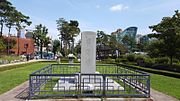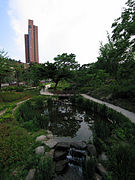Jangchungdan Park
| Jangchungdan Park | |
|---|---|
 A waterfall in the park (2012) | |
 | |
| Location | 261, Dongho-ro, Jung District, Seoul[1] |
| Area | 297 square kilometres (29,700 ha) |
| Established | 1919 |
| Korean name | |
| Hangul | 장충단 공원 |
| Hanja | 奬忠壇公園 |
| Revised Romanization | Jangchungdan Gongwon |
| McCune–Reischauer | Changch'ungdan Kongwŏn |
Jangchungdan Park (Korean: 장충단 공원) is a park located in Jung District, Seoul, South Korea. It is to the northeast of the mountain Namsan.[1][2]
It contains the historic Dangchungdan Shrine, which was built by Emperor Gojong in 1900 to memorialize Empress Myeongseong. The park has a children's baseball field, a tennis court, and a swimming pool. It is popular for walks and for exercise. It has a pine tree forest, with walking trails through it.[2]
History[edit]
After the 1895 assassination of Empress Myeongseong, her husband Emperor Gojong built the Jangchungdan Shrine as a memorial to her in November 1900 in this area.[1][2] Around the time, the area was known just as "Jangchungdan".[2]
Japanese colonial period[edit]
It became a park in 1919,[1] during the Japanese colonial period. After the 1932 January 28 incident (a conflict between Japan and China), a statue was erected dedicated to Japanese soldiers who died during it. The statue was quickly torn down just after Korea was liberated in 1945.[2]
Post-liberation[edit]
The shrine was destroyed during the Korean War,[1] although it was eventually rebuilt.[2]
In 1959, the historic bridge Supyogyo, which had stood over the stream Cheonggyecheon since 1420, was dismantled and moved to this park. A device used to measure the water level (수표; supyo) was also moved to the park. Both have since been designated Tangible Cultural Heritages of Seoul (No. 18 and 838 respectively).[3]
In 1964, a bronze statue of Yi Tjoune was erected in the park, and a statue of Yujeong in 1968. The rebuilt monument was designated a Tangible Cultural Heritage of Seoul in 1969.[2]
On September 22, 1984, the park, which had an area of 418,000 square metres (4,500,000 sq ft) since 1940, had a portion of it merged into Namsan Park. Its new area was 297,000 m2 (3,200,000 sq ft).[1][2]
There are now a number of other monuments in the park that commemorate the March 1st Movement, the Korean independence movement, independence activist Yu Gwan-sun and Buddhist reformer Han Yong-un.[1][2]
Between February and April 2022, the Seoul Museum of History ran an exhibition about the history of the park.[4]
Gallery[edit]
See also[edit]
- Hyochang Park: another historic park in Seoul with monuments to the independence movement
References[edit]
- ^ a b c d e f g "Jangchungdan Park (장충단공원)". Korea Tourism Organization. Retrieved 2023-08-22.
- ^ a b c d e f g h i "장충단공원(奬忠壇公園)". Encyclopedia of Korean Culture (in Korean). Retrieved 2023-08-22.
- ^ "Historic Sites of Cheonggyecheon Stream, Seoul (Gwangtonggyo Bridge, Supyogyo Bridge, and Ogansumun Watergate Site) - Heritage Search". Cultural Heritage Administration. Retrieved 2023-08-22.
- ^ "Jangchungdan Park: A Place of Remembrance and Rejoice | Exhibition > Lobby Exhibition | SEOUL MUSEUM OF HISTORY". museum.seoul.go.kr. Retrieved 2023-08-22.



